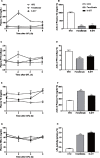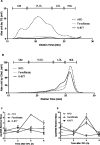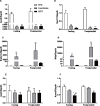A Novel Selective PPARα Modulator (SPPARMα), K-877 (Pemafibrate), Attenuates Postprandial Hypertriglyceridemia in Mice
- PMID: 28781340
- PMCID: PMC5827084
- DOI: 10.5551/jat.39693
A Novel Selective PPARα Modulator (SPPARMα), K-877 (Pemafibrate), Attenuates Postprandial Hypertriglyceridemia in Mice
Erratum in
-
A Novel Selective PPARα Modulator (SPPARMα), K-877 (Pemafibrate), Attenuates Postprandial Hypertriglyceridemia in Mice.J Atheroscler Thromb. 2018 Oct 1;25(10):1086. doi: 10.5551/jat.ER39693. Epub 2018 Sep 7. J Atheroscler Thromb. 2018. PMID: 30197400 Free PMC article. No abstract available.
Abstract
Aims: Fasting and postprandial hypertriglyceridemia (PHTG) are caused by the accumulation of triglyceride (TG)-rich lipoproteins and their remnants, which have atherogenic effects. Fibrates can improve fasting and PHTG; however, reduction of remnants is clinically needed to improve health outcomes. In the current study, we investigated the effects of a novel selective peroxisome proliferator-activated receptor α modulator (SPPARMα), K-877 (Pemafibrate), on PHTG and remnant metabolism.
Methods: Male C57BL/6J mice were fed a high-fat diet (HFD) only, or an HFD containing 0.0005% K-877 or 0.05% fenofibrate, from 8 to 12 weeks of age. After 4 weeks of feeding, we measured plasma levels of TG, free fatty acids (FFA), total cholesterol (TC), HDL-C, and apolipoprotein (apo) B-48/B-100 during fasting and after oral fat loading (OFL). Plasma lipoprotein profiles after OFL, which were assessed by high performance liquid chromatography (HPLC), and fasting lipoprotein lipase (LPL) activity were compared among the groups.
Results: Both K-877 and fenofibrate suppressed body weight gain and fasting and postprandial TG levels and enhanced LPL activity in mice fed an HFD. As determined by HPLC, K-877 and fenofibrate significantly decreased the abundance of TG-rich lipoproteins, including remnants, in postprandial plasma. Both K-877 and fenofibrate decreased intestinal mRNA expression of ApoB and Npc1l1; however, hepatic expression of Srebp1c and Mttp was increased by fenofibrate but not by K-877.Hepatic mRNA expression of apoC-3 was decreased by K-877 but not by fenofibrate.
Conclusion: K-877 may attenuate PHTG by suppressing the postprandial increase of chylomicrons and the accumulation of chylomicron remnants more effectively than fenofibrate.
Keywords: Chylomicron remnants; Fenofibrate; K-877 (Pemafibrate); Postprandial hypertriglyceridemia; SPPARMα.
Conflict of interest statement
SY received an advisory fee from Kowa Company, Ltd.. SY and DM received research funds as a joint research with Kowa Company, Ltd.. K-877 powder was provided under a material transfer agreement from Kowa Company, Ltd.
Figures




Comment in
-
Effects of a Novel Selective Peroxisome Proliferator-Activated Receptor α Modulator K-877 (Pemafibrate) on Postprandial hyperlipidemia.J Atheroscler Thromb. 2018 Feb 1;25(2):126-127. doi: 10.5551/jat.ED088. Epub 2017 Oct 18. J Atheroscler Thromb. 2018. PMID: 29046503 Free PMC article. No abstract available.
References
-
- Hokanson JE, Austin MA: Plasma Triglyceride Level is a Risk Factor for Cardiovascular Disease Independent of High-Density Lipoprotein Cholesterol Level: A Metaanalysis of Population-Based Prospective Studies. Eur J Cardiovasc Prev Rehabil, 1996; 3: 213-219 - PubMed
-
- Iso H, Naito Y, Sato S, Kitamura A, Okamura T, Sankai T, Shimamoto T, Iida M, Komachi Y: Serum triglycerides and risk of coronary heart disease among Japanese men and women. Am J Epidemiol, 2001; 153: 490-499 - PubMed
-
- Schwartz GG, Abt M, Bao W, DeMicco D, Kallend D, Miller M, Mundl H, Olsson AG: Fasting Triglycerides Predict Recurrent Ischemic Events in Patients With Acute Coronary Syndrome Treated With Statins. J Am Coll Cardiol, 2015; 65: 2267-2275 - PubMed
-
- Nordestgaard BG, Benn M, Schnohr P, Tybjaerg-Hansen A: Nonfasting triglycerides and risk of myocardial infarction, ischemic heart disease, and death in men and women. JAMA, 2007; 298: 299-308 - PubMed
-
- Zilversmit DB: Atherogenesis: a postprandial phenomenon. Circulation, 1979; 60: 473-485 - PubMed
MeSH terms
Substances
LinkOut - more resources
Full Text Sources
Other Literature Sources
Medical
Research Materials
Miscellaneous

